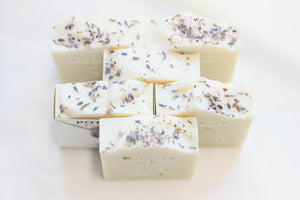WHAT IS SAPONIFICATION?
Sep 22, 2023
Soap manufacturing traces back thousands of years. Archeologists discovered records of soap making inscribed on clay tablets in Mesopotamia from 3000 BC and there is evidence of soap use in both early Roman and Egyptian civilization. By the 1600s in Europe, with the finding of Louis Pasteur, there was a strong movement toward good hygiene. Doctors began prescribing the use of soap. Today more than ever, and especially since the pandemic, we know the importance of washing with soap.
No matter how soap is made, whether in a large kettle with heat, or using the cold-process method as we do here at Potager Soap, all soaps share a few common traits. Soap is a salt, created through a chemical reaction that occurs when a fatty acid and a base are combined. This reaction is called saponification.
For today’s purposes, we’re going to explain Saponification in its simplest form and explain the basics of how Potager’s castile soap is made.

WHAT IS SAPONIFICATION?
Saponification is a process that converts fats, oils, or lipids (the acid) into soap by combining them with Sodium Hydroxide (the base). The chemical reaction relies on friction and self-generated heat. Through saponification, the acid and the base are neutralized. One of our favorite soap formulas is as follows: Combine organic olive oil, organic coconut oil, organic RSPO palm oil, and organic shea butter with sodium hydroxide. Knowing the proportions of acid to base needed for saponification is the key. We determine this by knowing the SAP value of each oil (acid) in the formula (there are charts for this). The SAP value is the amount of sodium hydroxide needed to completely saponify a particular oil. Each type of oil whether vegetable or animal has a different SAP value based on its molecular structure.
HOW SAPONIFICATION WORKS
Once the proper amount of acid and base are combined, the chemical reaction begins, but this is not where our soapmaking ends. As we stir, the oils go from translucent to opaque. Then, we look for a trace. A trace is a telltale sign that our cold-process soap has reached a point in saponification where we can start to incorporate additives. We know our soap has traced when the spatula leaves a noticeable trail when drizzled.
Potager then adds certified organic essential oils to create skin-nourishing soap with aroma-therapeutic properties. This is also when we add any botanicals, like organic rose powder or organic calendula powder. Saponification is now well underway! Next, we pour our soap into molds and add botanical dressings. The molds are placed in a draft-free environment and kept warm for a period of time to facilitate the continuing saponification. The molds will continue to generate heat from the chemical reaction for a period of hours. Once cooled, the soap will be ready to unmold and cut. Saponification is virtually complete at this point. The soap is left to cure and harden for a period of time before it is ready for use.
In modern days, and especially here at Potager, we take great care in creating beautiful artisan soaps with skin nourishing ingredients, but it seems likely that the earliest form of soap was accidentally created. The legend says there was temple in Rome on a hillside above a river. A foaming substance was found seeping into river below the temple. It seems that rendered fats (acid) from roasted animal sacrifices would combine with ash (base) from the fire and be washed by rain down the hillside. Women noticed how clean their clothes became when washed in this foamy substance.
Our mission at Potager is to make soap as clean and natural as possible. Our formulas only include certified organic ingredients, and as a result, we’re able to create beautiful soap without any harsh chemicals, manufactured preservatives, or synthetic fragrances.

